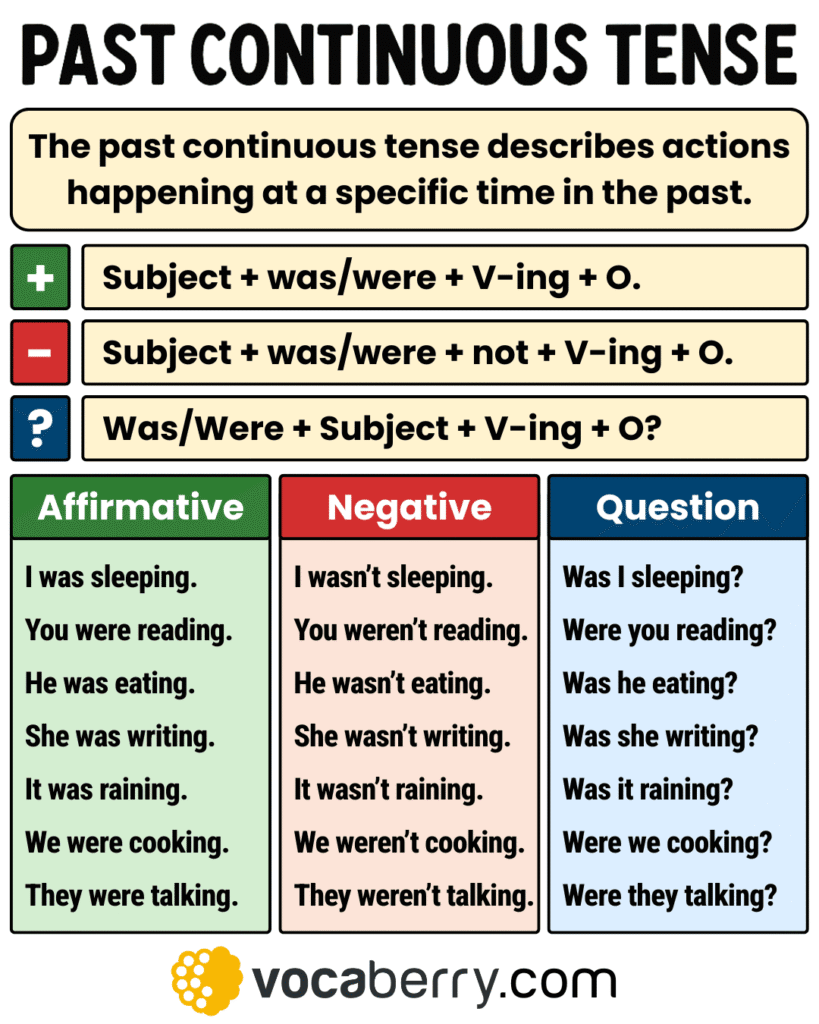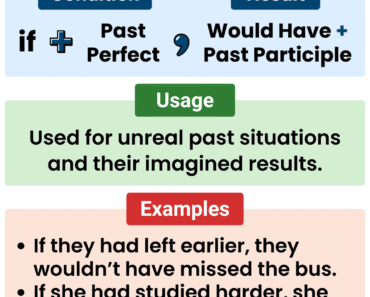
The past continuous tense is used to describe actions that were ongoing at a specific time in the past. It often sets the background for another past event or shows two actions happening at the same time. The structure combines was/were + verb-ing, making it useful for expressing interrupted actions, gradual developments, and past atmosphere.
In this lesson, you’ll learn how to form and use the past continuous tense in affirmative, negative, and question forms, understand its structure and usage, explore essential grammar rules, and apply common time expressions—all with clear examples.
When to Use the Past Continuous Tense
The past continuous tense describes actions or situations that were ongoing at a certain moment in the past. It’s especially useful for showing the duration of a past event, background activity, or when another action interrupts it. Here are the most essential uses:
1. Interrupted Past Actions
Used when one longer action in the past was interrupted by another shorter action (usually in the simple past).
- I was watching TV when the phone rang.
- She was walking to school when it started to rain.
- They were eating dinner when the power went out.
2. Parallel Actions in the Past
Describes two or more actions happening at the same time in the past.
- I was reading while he was cooking.
- The children were playing and the parents were talking.
- She was listening to music as she was painting.
3. Setting the Scene or Background
Used to describe what was happening around a specific time, often to give background for a story.
- The sun was setting, and birds were singing.
- People were dancing, and the band was playing loudly.
- Everyone was chatting while I was waiting quietly.
4. Describing Temporary Past Habits or Routines
Shows a repeated or regular action in the past, often with a sense of temporary duration.
- I was going to the gym every day that summer.
- He was working late during the project deadline.
- They were meeting up regularly at the café last year.
Past Continuous Tense Structure
The past continuous tense is formed using the past tense of the verb “to be” (was/were) followed by the present participle (verb + -ing). This tense describes actions that were ongoing or in progress at a specific time in the past. It’s also used for background descriptions, interrupted actions, or simultaneous events.
Affirmative Form
Use the affirmative form to describe an action that was happening at a specific moment in the past.
Structure: Subject + was/were + verb-ing
Examples:
- I was reading a book when she called.
- They were playing football all afternoon.
- She was cooking dinner at 6 PM.
Negative Form
Use the negative form to express that an action was not happening at a certain time in the past.
Structure: Subject + was/were + not + verb-ing
Examples:
- He wasn’t watching TV when I got home.
- We weren’t listening during the meeting.
- I was not working last night.
Question Form
Use the question form to ask whether an action was in progress at a specific time.
Structure: Was/Were + subject + verb-ing?
Examples:
- Were you sleeping when I texted?
- Was she studying for the test last night?
- Were they arguing again?
Short Answers
Short answers are used for yes/no questions. Respond with “Yes” or “No” followed by the subject and was/were.
Examples:
- Was he sleeping? → Yes, he was. / No, he wasn’t.
- Were you working? → Yes, I was. / No, I wasn’t.
- Were they eating? → Yes, they were. / No, they weren’t.
Summary Table: Past Continuous Tense
| Type | Structure | Example |
|---|---|---|
| Affirmative | S + was/were + verb-ing | She was writing a letter. |
| Negative | S + was/were + not + verb-ing | We weren’t watching the game. |
| Question | Was/Were + S + verb-ing? | Were they dancing at the party? |
| Short Answer | Yes/No + S + was/were | Yes, she was. / No, they weren’t. |
Time Expressions with the Past Continuous Tense
Time expressions help show when an action was happening in the past. The past continuous tense often works with expressions that refer to a specific point in time, describe a background situation, or show actions that were happening simultaneously.
Below are the most common and useful time expressions used with the past continuous tense:
| Time Expression | Example Sentence |
|---|---|
| at that moment | I was driving home at that moment. |
| at 7 o’clock / at 10 AM | She was sleeping at 7 o’clock. |
| when | They were eating when the lights went out. |
| while | I was reading while he was watching TV. |
| all night / all morning | He was studying all night for the exam. |
| during the meeting | She was texting during the meeting. |
| the whole time | They were laughing the whole time. |
These time expressions can come at the beginning or end of a sentence.
- Use “when” to show a short action interrupting a longer one.
- Use “while” to show two actions happening together.






